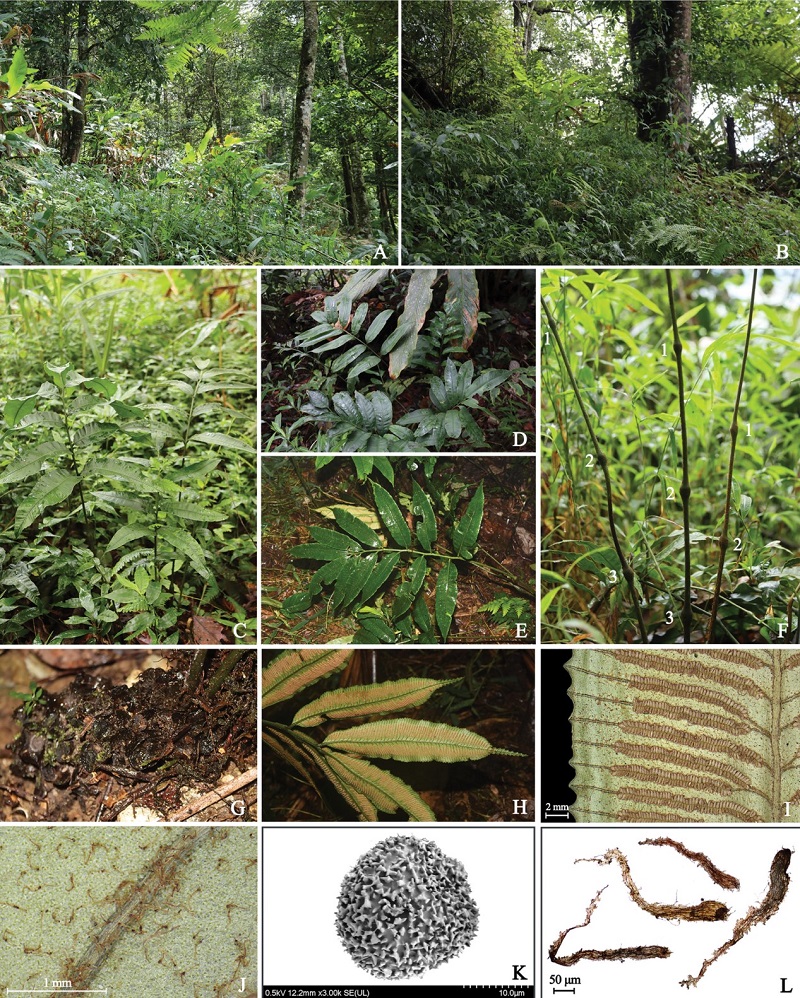Angiopteris nodosipetiolata (Marattiaceae), a new fern species from Yunnan, China
The genus Angiopteris Hoffmann, which belongs to the Eusporangiate ferns within the Marattiales Link and Marattiaceae Kaulf., is a crucial clade in the origin and evolution of ferns, offering significant ornamental, medicinal, edible, and scientific research value. Currently, Angiopteris is recognised to contain about 53 species in the world, with 30 species in China (18 of which are endemic). Due to the high similarity and difficulty in distinguishing between species within the genus, all plants in the genus are listed as Wild Plants Under State Protection in China.
In August 2022, a research team (Biodiversity Conservation and Utilization Research Group) led by Professor Hongfeng Chen from the South China Botanical Garden, Chinese Academy of Sciences, accompanied by Senior Engineer Jinguo Zhang, conducted a field survey of Angiopteris in the Gulinqing Nature Reserve in Yunnan Province. During the survey, they discovered a suspected new species within the genus, and immediately collected specimens for further morphological observations. After consulting Flora of China, literature, and data from websites like CVH and GBIF, the researchers noticed that this species exhibited distinct morphological characteristics from known species (Fig.1). For example, it is quite similar to A. chingii J.M. Camus in terms of having more than one naked pulvinus on the stipe and numerous joint-like hairs on the undersides of the mature pinnae. However, the former’s pinnae are lanceolate, occurring in 4-6 pairs, in contrast with the elliptical pinnae of the latter, which consist of only 2-3 pairs. Judging from the shape of laminae, this species also closely resembles A. latipinna (Ching) Z. R. He, W. M. Chu & Christenh. and A. subrotundata (Ching) Z. R. He & Christenh. Nonetheless, these two species exhibit only one naked pulvinus on the stipe and the surfaces of their mature pinnae, apart from the mid-rib, are smooth and hairless.
In July 2023, the research team returned to Gulinqing Nature Reserve to conduct a detailed survey and statistics on the natural environment, species number, and morphological features of this species, and collected molecular samples for chloroplast genome sequencing. Phylogenetic and genetic distance analysis revealed that this species is not closely related to the aforementioned morphologically similar species and exhibits significant genetic distance between species (Fig. 2). Integrating morphological and molecular systematic research, the team confirmed this species as a new species of the genus Angiopteris, named Angiopteris nodosipetiolata Ting Wang tris, H. F. Chen & Y. H. Yan based on its stipe characteristics with multiple pulvinus (Fig. 1F).
Currently, There are ca. 500 mature individuals of Angiopteris nodosipetiolata has been found at the type locality. According to IUCN standards, it is recommended that this new species be listed as Endangered (EN) and, like other members of the genus Angiopteris, be given second-level national protection. Potential species similar to Angiopteris nodosipetiolata might exist in nature reserves, as well as in areas with frequent human activities such as cities or rural areas. Only through active protection and scientific research can we ensure the preservation of the diversity and uniqueness of all life on Earth. The article was recently published in the PhytoKeys journal, with postdoctoral researcher Ting Wang as the first author, and researchers Hongfeng Chen and Yuehong Yan (The Orchid Conservation and Research Centre of Shenzhen) as co-corresponding authors. Article link: https://doi.org/10.3897/phytokeys.241.115175
First author information: Hongfeng Chen: associate professor. Plant Sciences Center, South China Botanical Garden, Chinese Academy of Sciences. Research field: Conservation Biology. E-mail: liyali@scbg.ac.cn ; Tel :15011794942.

Fig. 1 Angiopteris nodosipetiolata Ting Wang tris, H.F.Chen & Y.H.Yan
(A, B habitat; C, D, E lamina; F portion of stipes showing pulvini; G rhizome;
H, I sporangia; J pinnae backside, showing a dense covering of hairs; K exospores; L petiole scales.)

Fig 2. Figure 1. Maximum Likelihood and Bayesian Inference tree of Angiopteris species, based on(A) complete plastid genome sequences and (B) 84 CDSs. Maximum Likelihood bootstrap support (RBS)
and Bayesian Inference posterior probability (PP) are given above the branches. NA: written abbreviation for not available, used to show the sampling site cannot be provided.
File Download: